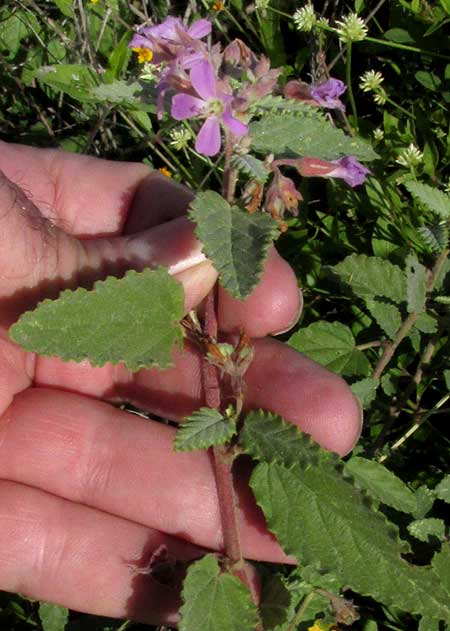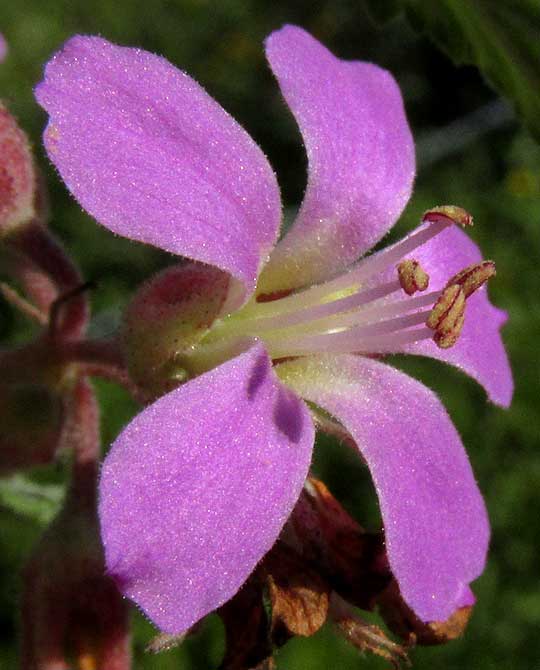Excerpts from Jim Conrad's
Naturalist Newsletter
from the November 16, 2014 Newsletter issued from Río Lagartos, on the Yucatan Peninsula's northern coast (~N21.60°, ~W88.16°), Yucatán state, MÉXICO
TEABUSH
Nowadays along weedy roadsides through the savanna and ranch areas south of Río Lagartos a much branched subshrub from knee to head high is prettily adorned with branch-tip clusters of five-petaled, thumbnail-sized, pink flowers, a stem of which is shown below:

Notice how the alternate leaves (one leaf per stem node) are so curiously toothed. Each tooth bends away from the blade's plane causing an unusual scalloped effect. A close-up of a flower is shown below:

That blossom bears five well developed stamens with brownish, pollen-releasing anthers, but we can't see anything of a female pistil. However, if you remove one side of the blossom, you find the pistil with its green, oval ovary where it should be in the center of the bottom of the flower, bearing its 5-branched, stigma-tipped styles atop a slender column, though the style branches reach only about half the stamens' lengths. This is shown below:

Having such short styles nestled below overarching anthers is a little curious because usually this kind of simple flower projects its style beyond the stamens' anthers, to avoid having an approaching pollinator brush pollen from the flower's own anthers onto its own female parts lower down.
In the above picture we can also see that the narrowly triangular calyx lobes, or sepals, are thickly covered with glandular hairs -- hairs topped with sticky, spherical glands. Also, at the bottom, left side of the blossom, notice a bulge with an open space just beneath it. That's the nectary, where the pollinator finds the nectar it wants.
The most interesting thing, however, is seen if you check several of these plants. In our last picture the female pistil rises only half as high as the stamens; on about half of other plants the situation will be just the opposite. Pistils will extend well beyond the corolla, but stamens rise only half as high. Such a blossom with dominant female parts is seen in cross section below:

To understand what was going it, first the plant needed to be identified. It's called Teabush or Pyramid Bush, MELOCHIA TOMENTOSA. On the Internet we can read that Teabush is a classic example of a plant that is "heterostylous-distylous." That means that the species produces two distinct "morphs." The flowers of one morph have vigorous stamens but degenerate pistil, while the other morph's flowers produce large pistils with undersized stamens. The flowers are thus predominantly male or female, though in each morph reduced structures of the repressed sex are present. Flowers with dominant female parts are called "pin flowers" while those with dominant stamens are called "thrum flowers"; the two morph types are present in approximately equal proportions.
Teabush is mostly a tropical plant distributed from Brazil north to southern Texas and Florida. In many places it's a typical roadside wide, as here, but it also lives in openings on rocky limestone hills, in coastal thorn thickets, savannas, and piney woods.
Teabush is a member of the big Hibiscus or Mallow Family, though before the days of genetic sequencing it was assigned to the mainly tropical Chocolate or Cacao Family, the Sterculiaceae. The Chocolate Family now has been lumped into the Hibiscus Family.
On the Internet you might be interested in a freely downloadable PDF document by Isabel Machado and Marlies Sazima entitled "Pollination and breeding system of Melochia tomentosa L. (Malvaceae), a keystone floral resource in the Brazilian Caatinga." The document is available at http://www.cpatsa.embrapa.br/public_eletronica/downloads/OPB1810.pdf.